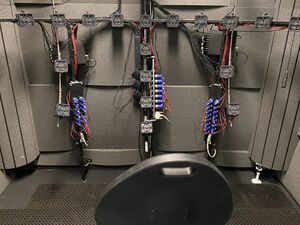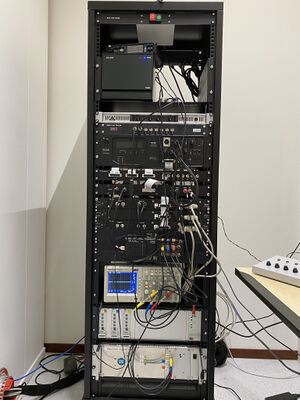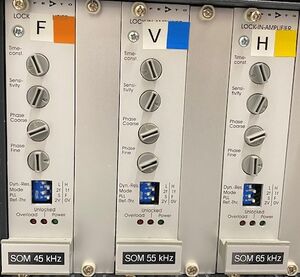Auditory Perception Lab technical info
back to Auditory Perception Lab
Introduction
The Auditory Perception setup is a sound boot with 43 speakers arranged in a quarter sphere. In the middle of the sphere is a chair where a person (the subject) can sit, so that his/her head is exactly in the center of the sphere. The subject can be presented with stimuli in the form of sounds or led flashes. The head movements of the subject can be tracked. The subject can also respond to stimuli by pressing a button. The experiments are controlled by a computer and electronics from outside the boot.
Booth

%todo
- Dimensions: LxWxH = 250x230x280cm
Description
The sound booth is an acoustically isolated room with sound absorbing materials on all walls and the floor to reduce reverberation. A 2.4 m diameter quarter sphere build of a metal structure holds 43 small passive speakers. The speakers also contain two color LED's. In the center of the booth there is a chair for a subject. The chair is placed in a way that the head of the subject is right in center of the sphere. Large coils are embedded in the walls of the sound booth. The coils make a box of about 2.5 m x 2.3 m x 2.8 m. These coils are used for head movement detection.
An infrared camera is installed in the booth. The experimenter has a monitor from which he/she can see the inside of the booth. The camera looks down on the back of the subject.
Acoustics
The Booth is acoustically isolated from its environment. The walls and corners are covered by acoustic panels. A double steel door isolates the booth from the operating room.
- Walls: Cinema Round Acoustic Panels
- Corners: Super Bass 90 Acoustic Panels.
- Floor: anti-fatigue rubber floor mat with holes
Coordinates
The orientation of the coordinates is determined by the position of the head of the subject looking to the center speaker. The raw acquisition data of the head coil results in tuples of voltages (Frontal, Vertical, Horizontal) which correspond to (X, Y, Z).
- Frontal (F) : Front is X+, Back is X-
- Vertical (V) : Top is Y+, Bottom is Y-
- Horizontal (H): Right is Z+, Left is Z-
For Double Polar coordinates see Coordinate systems
Computer
A windows computer with MATLAB, RPvdsEx and zBUSmon. The computer has an optical interface card (PO5e) for communication with the Tucker Davis equipment via the Optibit optical bus (FO5) at the back of the rack. The working of the optical bus can be monitored by the program zBUSmon program from TDT. This program has also some control functions for the optical bus. It shows all the connected zBus chassis and the TDT devices that are installed in each chassis. It also shows the version number of the installed firmware on the devices.
Software
The software consist of several parts:
- Matlab software for generating experiment files.
- Sphere Minor
- BIOX Prime (under construction)
- Matlab software that runs the experiments.
- BIOX (RPvdsX) software for the RZ6 soundprocessor.
GenExp
The software that generates a experiment file is called 'genexp_xxxxx'. In the \biofysica\experiment\exp directory there are five examples:
- genexp_defaultcal.m
- genexp_defaultloc.m
- genexp_fartloc.m
- genexp_glausndloc.m
- genexp_student.m
Sphere Minor
The software mostly used is called 'SphereMinor'. It is a reworked copy of the 'SpherePrime' program of the Sphere Setup. It can be found in the \biofysica\experiment\sphereMinor directory. It has a graphical user interface (GUI) and is, except for the GUI, written in the procedural programming paradigm. Several functions have a parameter 'handles' as input parameter and as output parameter. 'handles' is a struct that contains nearly all information that is moved around in the program. Every function has the ability to change 'handles'. This way it acts as a global data structure.
Biox Prime
A program 'Biox Prime' is under construction. This program has a GUI build in the app designer of Matlab. The program is mostly written in the Object Oriented Programming (OOP) paradigm. The core of the program is a state machine. Due to its structure the GUI stays always responsive. The programming of the RZ6 is based on the BIOX toolbox.
RPvdsX software
The BIOX sofware can be found in the \biofysica\experiment\biox_rz6 directory.
Electronics rack

From top to bottom:
- Rack main power switches
- Computer
- Quad channel amplifier
- Digital event recorder
- RZ6 Multi I/O Processor
- PP RZ6 Digital I/O (Patch panel)
- Left: PP Amp (Patch panel) ; Right: Multiplexer
- Left: <none> ;Right: Multiplexer
- Left: PP Audion (Patch panel; Right: Multiplexer
- 8 channel ADC acquisition device
- Oscilloscope
- Femto oscilator/Lock-in amplifier module
- Field coil generator (amplifier)
Sound system
The sound system consists of a programmable sound processor (RZ6) with each two DAC’s. The RZ6 generates a sound signal that travels via a multiplexer (TDT PM2R) to a patch panel inside the the booth and from there to a speaker. The multiplexing system consists of two TDT PM2relay multiplexers. Each multiplexer has 16 channels. Only one channels per multiplexer can be opened at a time. The total number of channels is 32. The RZ6 controls the multiplexers.
Parts
- RZ6
- TDT PM2relay Multiplexers (2x)
- Flat cables from RZ6 to PM2relays.
- Dsub25 cables from PM2relays to patch panels in the booth (2x)
- Patch panel inside the booth
- Speakers (30x)
Minx Min12 speaker system
On the sphere frame Cambridge Audio Minx Min12 speakers are used.
Speaker specifications:
- Sensitivity: 86 dB SPL (@2.83 Vrms input)
- Frequency response: 150 Hz-20 kHz
- Impedance: 8 Ohms
- H x W x D: 78 x 78 x 85 mm
- Weight: 0.43 kg
The speakers are connected via 2 lead wires for the sound and 3 lead wires with mini stereo jacks for the LED's.
The average distance from the subject (centre of the head) to the speakers is 1.05 m.
Azimuths and elevations were measured by %todo and are tabulated in %todo.
Speakers positions
| Azimuth (degree) | Device | Channel |
|---|---|---|
| 0 | 2 | 0 |
| -10 | 1 | 0 |
| -20 | 1 | 1 |
| -30 | 1 | 2 |
| -40 | 1 | 3 |
| -50 | 1 | 4 |
| -60 | 1 | 5 |
| -70 | 1 | 6 |
| -80 | 1 | 7 |
| -90 | 1 | 8 |
| 10 | 0 | 0 |
| 20 | 0 | 1 |
| 30 | 0 | 2 |
| 40 | 0 | 3 |
| 50 | 0 | 4 |
| 60 | 0 | 5 |
| 70 | 0 | 6 |
| 80 | 0 | 7 |
| 90 | 0 | 8 |
| Elevation (degree) | Device | Channel |
|---|---|---|
| 0 | 2 | 0 |
| 10 | 0 | 10 |
| 20 | 0 | 11 |
| 30 | 0 | 12 |
| 40 | 0 | 13 |
| 50 | 0 | 14 |
| 60 | 0 | 15 |
| -10 | 1 | 9 |
| -20 | 1 | 10 |
| -30 | 1 | 11 |
| -40 | 1 | 12 |
| Azimuth (degree) | Elevation (degree) | Device | Channel |
|---|---|---|---|
| -30 | -22.5 | 2 | 0 |
| -30 | -45 | 2 | 1 |
| -30 | -30 | 2 | 2 |
| -60 | -30 | 2 | 3 |
| 30 | 25 | 2 | 4 |
| 30 | 50 | 2 | 5 |
| 60 | 35 | 2 | 6 |
| 60 | 85 | 2 | 7 |
| -30 | -22.5 | 2 | 8 |
| -30 | -45 | 2 | 9 |
| -60 | -30 | 2 | 10 |
| 30 | 25 | 2 | 11 |
| 30 | 50 | 2 | 12 |
| 60 | 35 | 2 | 13 |
| 60 | 85 | 2 | 14 |
LED system
%todo
The system is triggered by the RZ6 output.
Parts
- DCN LED controller (2x)
- LED mounting frames (32x)
- Red/Green LED’s(32x)
- Mini-jack to mini-jack cables
Trigger/Timing system
Parts
- Pushbutton (passive switch, normally open)
- Digital event recorder (LSLDER02)
Head Tracking System
See EM Field Head Tracking System specifications
Lock-in amplifiers

Three Femto LIA-BV-150-H Lock-in amplifiers are used in order to separate the Frontal, Horizontal and Vertical signals from the pick-up coil. Each Lock-in amplifier has a Sinus Oscillator Module (SOM-1) that is used both as Field Modulation Signal and as Reference Signal. The Lock-in amplifier settings are set at the front of the device (see picture), except for the modulation/reference frequency which is set inside on the SOM-board.
| Setting | Frontal (Red) | Vertical (Blue) | Horizontal (Yellow) |
|---|---|---|---|
| Frequency | 45kHz | 55kHz | 65kHz |
| Time constant | B | B | B |
| Sensitivity | 5 | 5 | 5 |
| Phase Course | F | F | 7 |
| Phase Fine | 4 | 7 | 4 |
| Dynamic Reserve | L | L | L |
| Mode | 1f | 1f | 1f |
| PLL | S | S | S |
| Reference Threshold | 0V | 0V | 0V |